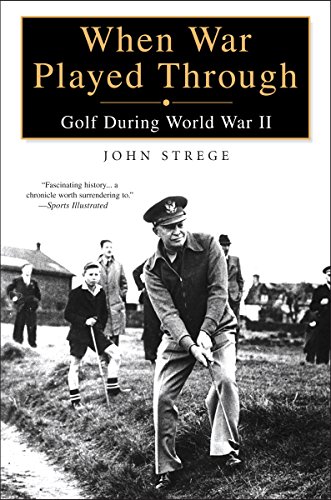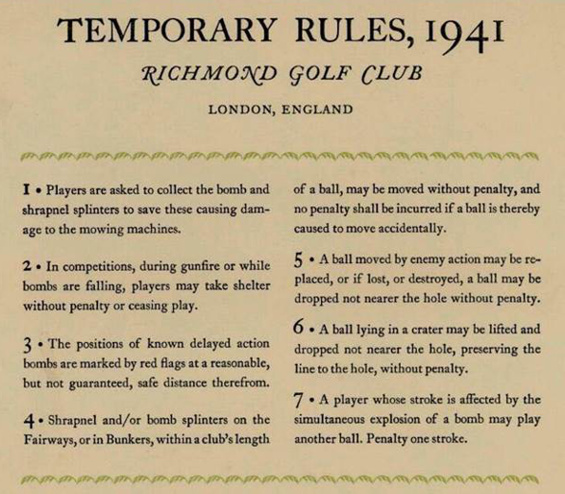Our country and much of the world have been grappling with the effects of the Covid-19 pandemic for months. Those of us who love golf have spent time reading, considering, and probably debating how golf has, will, and should be affected. It has been many decades since golf last grappled with these types of questions in a serious way. Not since the 1940s, during World War II, have majors been cancelled or postponed and professional tours suspended until further notice. That was also the last time that anyone debated whether it was safe, wise, or fair for courses to remain open.
In his book “When War Played Through: Golf During World War II,” John Strege does a fantastic job exploring how the war affected golf and golfers. While reading it recently I was amazed at how many of the questions and debates we’ve had about golf during the coronavirus pandemic mimic those that took place during the 1940s even though the respective causes are very different.

We’ve all watched as politicians have tried to figure out if and how we should be able to play golf during the pandemic. This was also a question throughout WWII. In his book Strege includes a letter written by Bobby Jones to O.B. Keeler on the topic of playing golf during the war. It reads, in part,
“ . . . The production we face now is far greater than that of the previous war. It is going to require the most efficient use of all the resources we possess. The men who work with their hands are of vast importance, but the real McCoys are the fellows who know how to set up a production schedule and make it click – in short, the managers. And they need breathing spells in their thinking as much as the workmen need rest for their hands. They can take a walk or pull the weights, or ride a bike for physical exercise. But the best way for them to get exercise, fresh air, and mental relaxation at the same time is to play golf. They can’t do much worrying on a golf course. I think a judicious use of the game can prevent a lot of jitters and nervous breakdowns. I wish you would check this angle with some of your psychologist friends. It might be a sale you ought to make.
Of course no one would suggest that a sport should compete with War production for materials, facilities, time, or energy. But if playing of a little golf can replenish energy and revive the spirit, it should be continued . . .
From the standpoint of the tournaments, I can see reason in the decision to abandon the major championships. If they are not representative they lose their point, and they could not be representative under war conditions. The winter tournaments are somewhat different. Where local conditions are not favorable, and enough good players are to hand, they offer a diversion which might do some good.
It seems to me that the whole question here, as elsewhere, is to keep as much of everything as nearly normal as may be so long as it takes nothing in men, materials, or time from our war effort . . .”
One can easily see a reflection of Jones’ thinking in the debates we’ve had over the last few months. Many have argued that playing golf is helpful when we are restrained from doing so many other activities especially given the opportunity it presents to spend time outside getting fresh air and exercise. Jones admitted that it shouldn’t be done in a way that undermines what the nation has been mobilized to do, and similarly many golfers who have continued to play during the Covid-19 pandemic have implemented new practices to keep with social distancing and other guidelines issued to help us through this time.
In his letter Jones foreshadows what would ultimately happen with golf’s major championships during wartime as many were cancelled. In his book Strege goes into detail about the somewhat controversial history of the Hale America National Open Golf Tournament won by Ben Hogan in 1942. Many consider that tournament a replacement for the US Open that year, and there have already been comparisons drawn to the US Open we’ll see this year at Winged Foot now that the USGA has cancelled the qualification process and will only invite exempt players.
One thing we can be thankful for is that our courses now aren’t facing some of the challenges faced during WWII, especially for those in Great Britain. In his book Strege explains how some courses were used to stage anti-aircraft weapons and therefore became targets of the Luftwaffe. Other courses were determined to be too tempting as a staging area for ground invasion so the British added land mines and barbed wire to them. Famous golf resorts were also forced into a new kind of service. Strege explains that the Greenbrier in West Virginia was turned into a POW camp. Turnberry in Scotland “transformed its course into an airport by constructing hangars and turning its fairways into landing strips for RAF planes. But as a result it became a Luftwaffe target too. German bombs left craters of a size that with a little sand might have made serviceable bunkers. The Turnberry Hotel, meanwhile, temporarily became a military hospital.” Additionally, Augusta National was turned into a literal cow pasture.

We’ve already seen four of the world’s top players compete in a charity match, and we’ll soon see Tiger, Phil, Peyton, and Tom do the same. This isn’t so different from how funds were raised in the 1940s to help the war effort. Strege describes the efforts of Byron Nelson and celebrities like Bob Hope and Bing Crosby as they toured the country together playing in exhibitions to raise money to help with the war effort. However, we probably won’t hear stories of Tiger being criticized for driving his car with out-of-state plates the way Nelson was. Gas was being rationed and people didn’t recognize Nelson or the good work he was doing in his travels. As long as Tiger doesn’t touch a flagstick, he’s likely to escape similar backlash.

The coronavirus pandemic has changed how we think about golf in ways that were almost unimaginable in recent years. However, when we look back in history we can see that some of the challenges and debates about how golf can endure are not occurring for the first time. In looking back to the 1940s we can be confident that the sport we love can and will survive this challenging time and continue to flourish in the future. Whether you are a fan of just history, just golf, or golf history, John Strege’s book about golf during World War II is a fascinating read with stories about everything from the rationing of golf balls to how the professional game was impacted. The material it covers is particularly interesting with current 2020 events in mind.
